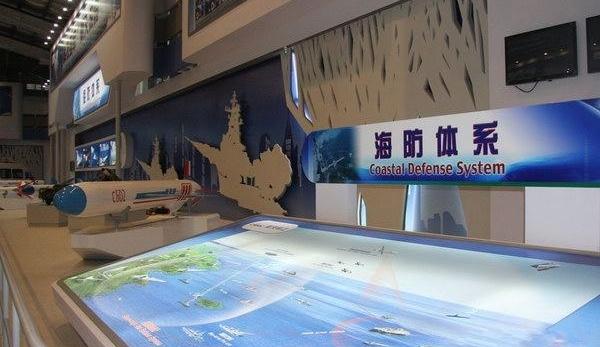
China Unveils Sea Defense System to Counter Aircraft Carrier
Publication: China Brief Volume: 10 Issue: 23
By:

The modernization of China’s aerospace capabilities was prominently on display at the Eighth China International Aviation and Aerospace Exhibition (2010 Zhuhai Air Show). The biannual air show, which is taking place from November 16-21 in the southeastern province of Guangdong, involves more than 600 domestic and foreign aerospace defense manufacturers and exhibitors. Apart from the state-of-the-art weapon systems displayed at the show, the roll out by Chinese-defense manufacturers in this year’s expo stood apart from previous years in significant ways.
While much have been reported about the capabilities of China’s new weapon systems (e.g. unmanned technologies, missiles, etc.), much less have been said about how Chinese military planners intend to deploy these systems on the battlefield. Taking into account the Chinese proclivity to “keep a low profile,” especially when it comes to military planning, it has come as a surprise to outside observers that state-owned China Aerospace Science & Industry Corporation (CASIC)—one of the country’s largest defense manufacturers—displayed a detailed diagram in the main hall of the international air show depicting, in not-so-subtle terms, an integrated “Coastal Defense System” of Chinese ground, naval, air and space assets coordinating an attack on an un-flagged aircraft carrier group approaching a small island off the coast of China (Global Times, November 16; Wen Wei Po [Hong Kong], November 17). Additionally, it was reported by Defense News that in one promotional video, a CASIC-made unmanned aerial vehicle (UAV) locates an aircraft carrier and relays the information for a follow-on attack by Chinese anti-ship missiles (Defense News, November 16).
It is no surprise that Chinese defense planners are concerned about the presence of aircraft carriers in the Western Pacific, yet the CASIC exhibit is the first time that it publicly showed ‘how’ Chinese forces may counter the advances of an aircraft carrier group. The multiple platforms on display provides a glimpse into Chinese defense thinking on how the various capabilities offered by some of its advanced weapon systems may be integrated and deployed in operations to counter an aircraft carrier.
According to the CASIC diagram, China can monitor the carrier’s movements with submarines and UAVs, which will then relay information to a coastal command center. Chinese forces can then attack the carrier group with fighter jets and cruise and ballistic missiles. As part of China’s far sea defense system, three different missiles would be deployed simultaneously to attack the approaching carrier. Noticeably absent in the display was the DF-21D anti-ship ballistic missiles (Global Times, November 16; Wen Wei Po [Hong Kong], November 17).
The missiles on display were the C-602, C-705 and C- 802A, which are all domestically made by the Third Academy under CASIC, and together attack the carrier from the ground, air and water. This so-called “anti-aircraft carrier system,” which has become the focus of the Chinese-media, has prompted the media to dub the missiles the “the three anti-aircraft carrier musketeers.” The attack is assisted by space-based satellites and high altitude UAV, which are used to assess and relay battlefield communications (Global Times, November 16; Wen Wei Po, November 17).
C-602 (YJ-62) is a sub-sonic and long range anti-ship cruise missile (ASCM) for use by surface ships. The mid-course guidance system of the C-602 is a combination of Inertial Navigation System (INS) and Beidou Positioning System. The YJ-62 also has terminal guidance system and active radar seeker at the terminal phase of flight (approx 40 km) that raises its hit rate (China Defense Mash Up, October 11, 2008).
C-705 is an air-launched anti-ship missile, which is the latest variant of the C-701 series, featuring a maximum range of 75 km without the rocket-booster, or 170 km when fitted with a rocket–booster. The mid-course guidance system is based on a combination of GPS and INS. The missile carries a 110 kg warhead and flies at an attitude of 12.15 m above the sea level.
C-802A (YJ-82) is an improved variant of YJ-82 subsonic missile with terminal guidance radar seeker. The mid-course guidance system is based on the INS. The missile has a 165 kg armor-piercing warhead. The missile’s flight altitude varies from 20-30 m cruise to 7 m at the terminal stage with range extended to 180 km. C-802A missile length 6.8 m, diameter 360 mm, weight 682 kg, can carry 165 kg of warhead weight.
While these weapon systems alone do not represent major advances in China’s military capabilities—many of these systems actually made its debut in previous shows—the diagram presents a conceptual model that presents integrated weapon platforms executing an attack, which demands a high degree of interoperability and integrated war-fighting planning. This model appears consistent with trends in some Chinese military exercises in the East and South China Sea.
As China continues to modernize its aerospace capabilities, it will increasingly be able to integrate existing weapon platforms and alter the calculus of forces required for sea control. While the CASIC diagram is only a model, it does a represent a trend in Chinese defense thinking toward greater interoperability and a layered defense strategy for near-and fear-sea defense. The prominent role of UAVs at the air show also suggests that its battlefield applications are becoming more defined in Chinese defense planning. As China strengthens its C4I (Command, Control, Communications, Computing and Intelligence) structure and integrates its other operating weapon systems, it could greatly enhance the Chinese military’s capability to execute near-and far-sea defense missions and an effective anti-access/area denial strategy.





